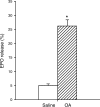Heparin normalizes allergen-induced nitric oxide deficiency and airway hyperresponsiveness
- PMID: 15265801
- PMCID: PMC1575183
- DOI: 10.1038/sj.bjp.0705848
Heparin normalizes allergen-induced nitric oxide deficiency and airway hyperresponsiveness
Abstract
It has been established that polycations cause airway hyperresponsiveness (AHR) to methacholine by inducing a deficiency of constitutive nitric oxide synthase (cNOS)-derived bronchodilating nitric oxide (NO). Since a deficiency of cNOS-derived NO also contributes to allergen-induced AHR after the early asthmatic reaction (EAR) and since this AHR is associated with the release of polycationic proteins from infiltrated eosinophils in the airways, we hypothesized that endogenous polycations underlie or at least contribute to the allergen-induced NO deficiency and AHR. Using a guinea-pig model of allergic asthma, we addressed this hypothesis by examining the effect of the polyanion heparin, acting as a polycation antagonist, on the responsiveness to methacholine of isolated perfused tracheae from unchallenged control animals and from animals 6 h after ovalbumin challenge, that is, after the EAR. A 2.0-fold AHR (P<0.001) to intraluminal administration of methacholine was observed in airways from allergen-challenged animals compared to control. Incubation of these airways with 250 U ml(-1) heparin completely normalized the observed hyperresponsiveness (P<0.001), whereas the responsiveness to methacholine of airways from unchallenged control animals was not affected. The effect of heparin on airways from allergen-challenged guinea-pigs was dose-dependently (0.1 and 1.0 mM) reversed by the NOS inhibitor L-NAME (P<0.01). These results indicate that endogenous (presumably eosinophil-derived) polycations are involved in allergen-induced NO deficiency and AHR after the EAR, probably by inhibition of l-arginine transport.
Figures



References
-
- AALBERS R., KAUFFMAN H.F., VRUGT B., KOETER G.H., DE MONCHY J.G. Allergen-induced recruitment of inflammatory cells in lavage 3 and 24 h after challenge in allergic asthmatic lungs. Chest. 1993;103:1178–1184. - PubMed
-
- AHMED T., CAMPO C., ABRAHAM M.K., MOLINARI J.F., ABRAHAM W.M., ASHKIN D., SYRISTE T., ANDERSSON L.O., SVAHN C.M. Inhibition of antigen-induced acute bronchoconstriction, airway hyperresponsiveness, and mast cell degranulation by a nonanticoagulant heparin: comparison with a low molecular weight heparin. Am. J. Respir. Crit. Care Med. 1997;155:1848–1855. - PubMed
-
- AHMED T., GARRIGO J., DANTA I. Preventing bronchoconstriction in exercise-induced asthma with inhaled heparin. N. Engl. J. Med. 1993;329:90–95. - PubMed
-
- AHMED T., SYRISTE T., MENDELSSOHN R., SORACE D., MANSOUR E., LANSING M., ABRAHAM W.M., ROBINSON M.J. Heparin prevents antigen-induced airway hyperresponsiveness: interference with IP3-mediated mast cell degranulation. J. Appl. Physiol. 1994;76:893–901. - PubMed
-
- AHMED T., UNGO J., ZHOU M., CAMPO C. Inhibition of allergic late airway responses by inhaled heparin-derived oligosaccharides. J. Appl. Physiol. 2000;88:1721–1729. - PubMed
Publication types
MeSH terms
Substances
LinkOut - more resources
Full Text Sources
Medical

